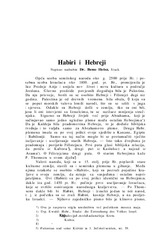Приказ основних података о документу
Habiri i Hebreji
Habiri and Hebrews
| dc.contributor | Fischer, Leopold | |
| dc.creator | Heisz, Beno | |
| dc.date.accessioned | 2021-03-03T20:22:30Z | |
| dc.date.available | 2021-03-03T20:22:30Z | |
| dc.date.issued | 1928 | |
| dc.identifier.uri | https://www.jevrejskadigitalnabiblioteka.rs/handle/123456789/1666 | |
| dc.description.abstract | U raspravi o značenju izraza Habiri i Hebreji (Jevreji) nadrabin dr Beno Heisz iznosi nekoliko naučnih mišljenja i istorijskih činjenica o njihovom poreklu. U uvodnom delu objašnjava da je opšta seoba semitskog naroda oko 2500 godine pre Hrista i seoba Izraelaca oko 1800. god. pre Hrista, promenila lice Prednje Azije i unela nov život i novu kulturu u područje Jordana. Glavno poprište istorijskih događaja bila je Palestina. Za njeno prisvajanje dugi niz godina naročito su se borili Hebreji i Filistejci. Palestina je od drevnih vremena bila raskrsnica naroda koji se se selili sa juga i severa. Mišljenja stručnjaka se razilaze po pitanjima ko su bili i odakle su Hebreji došli i da li su istovetni sa Izraelcima. Hebreji su živeli još i pre Abrahama, koji je sačinjavao samo jedno ugledno pleme među ostalim Hebrejima. Druga hebrejska plemena imala su po svoj prilici svoje sedište u Kananu, Egiptu i Vavilonu. Samo na taj način moglo bi se protumačiti večito iseljavanje i useljavanje starih Hebreja. Narodi koji su u 15. veku p.n.e preplavili stare kulturne zemlje, pokrenuli su i semitska plemena. Među njima su se naročito istakli "Habiri", koji su pozvali pojedine kraljeve u svoju zemlju, da ratuju sa susedima i ostalim neprijateljima. Jedno od mišljenja koje dr Heisz analizira je da su ovi (Habiri) po svoj prilici identični sa Hebrejima; dakle iza 1450. godine p.n.e. počinje prvo useljavanje Izraelaca, koje se završilo osnivanjem kraljevstva. Autor navodi delo Petera Thomsen-a "Pälestina und seine Kultur" in 5. Jahrtausende koji smatra da su Habiri, Hebreji i Izraelci jedan te isti narod, tj. da su se u početku zvali Habiri, kasnije Hebreji, a na kraju Izraelci. Ovo Thomsenovo mišljenje slede i prof. Gavro Manojlović u svom delu "Povijest staroga Orijenta" i prof. Sović u svom delu "Habiri i Izraelci". Iako dr Heisz smatra da je njihov rad značajan primećuje da ne postoji biblijsko-istorijska podloga i da tvrdnja ne odgovara istorijskim činjenicama. Dr Heisz smatra da je poistovećivanje Hebreja i Habira izmišljena hipoteza pošto se iz starog talmudskog izvora (Gitin, Jebamot, Kidušin) jasno vidi da su Habiri bili neki stari perzijski narod, koji je prema izraelskom ili judejskom narodu često bio neprijateljski raspoložen. U navedenom talmudskom izvoru su istodobno veoma lepo opisani religiozni običaji "Habira" i njihove religiozne ceremonije koje nemaju nikakve sličnosti sa religioznim običajima starih Hebreja. | sr |
| dc.description.abstract | In the discussion on the meaning of the terms Habiri and Hebrews (Jews), Dr Rabbi Beno Heisz presents several scientific opinions and historical facts about their origin. In the introductory part, he explains that the general migration of the Semitic people around 2500 BC and the migration of Israelis around 1800. BC changed the face of Asia Minor and brought a new life and a new culture to the Jordan area. The main scene of historical events was Palestine. The Jews and the Philistines, in particular, fought for its appropriation for many years. Palestine has been a crossroads of peoples migrating from the south and the north since ancient times. Experts differ on who they were and where the Hebrews came from and whether they are identical with the Israelites. The Hebrews lived even before Abraham, who made up only one respectable tribe among the other Hebrews. Other Hebrew tribes probably had their headquarters in Canaan, Egypt, and Babylon. Only in this way could the eternal emigration and immigration of the ancient Hebrews be interpreted. The peoples who flooded the old cultural lands in the 15th century BC also started Semitic tribes. Among them, the "Habiri" stood out, who invited certain kings to their country to fight with their neighbours and other enemies. One of the opinions that Dr Heisz analyzes is that these (Habiri) are probably identical with the Hebrews; hence after 1450 p.n.e. the first immigration of the Israelites begins, which ends with the establishment of the kingdom. The author cites the work of Peter Thomsen "Pälestina und seine Kultur" in the 5th Jahrtausende, who believes that the Habirians, Hebrews and Israelis are one and the same people, ie. that in the beginning they were called Habiri, later Hebrews, and finally Israelis. This opinion of Thomsen is followed by prof. Gavro Manojlović in his work "History of the Old Orient" and prof. Sović in his work "Habiri and the Israelis". Although Dr Heisz considers their work significant, he notes that there is no biblical-historical basis and that the claim does not correspond to historical facts. Dr Heisz believes that the identification of Hebrews and Habir is a fictional hypothesis since the old Talmudic source (Gittin, Jebamot, Kiddushin) clearly shows that the Habiri were an ancient Persian people, who were often hostile to the people of Israel or Judah. At the same time, the above-mentioned Talmudic source very nicely describes the religious customs of the "Habir" and their religious ceremonies, which bear no resemblance to the religious customs of the ancient Hebrews. | sr |
| dc.language.iso | sh | sr |
| dc.publisher | Vršac : Savez rabina Kraljevine S. H. S. | sr |
| dc.rights | openAccess | sr |
| dc.rights.uri | https://creativecommons.org/share-your-work/public-domain/cc0/ | |
| dc.source | Jevrejski almanah za godinu 5689 (1928/29) | sr |
| dc.subject | Jevreji - istorija | sr |
| dc.subject | Jews - history | sr |
| dc.title | Habiri i Hebreji | sr |
| dc.title | Habiri and Hebrews | sr |
| dc.type | article | sr |
| dc.rights.license | CC0 | sr |
| dcterms.abstract | Хеисз, Бено; Хабири и Хебреји; Хабири и Хебреји; | |
| dc.identifier.fulltext | http://jevrejskadigitalnabiblioteka.rs/bitstream/id/5224/JAL5689HabiriHebrejiOCR.pdf | |
| dc.type.version | publishedVersion | sr |
| dc.citation.spage | 118 | |
| dc.citation.epage | 120 | |
| dc.citation.volume | 4 | |
| dc.identifier.rcub | https://hdl.handle.net/21.15107/rcub_jdb_1666 |

